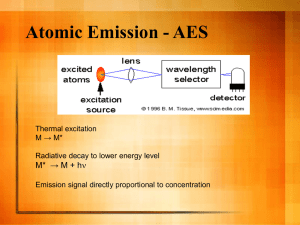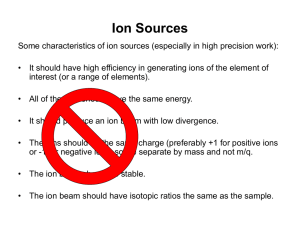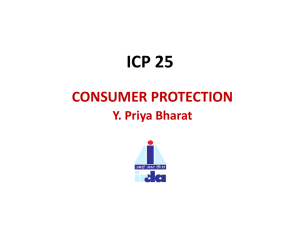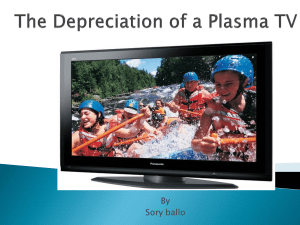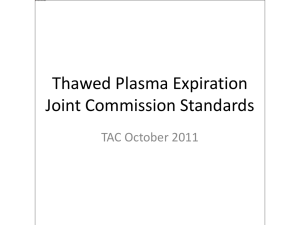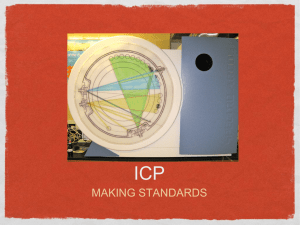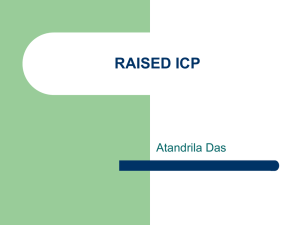Chemical Oceanography Laboratory Methods: Atomic
advertisement
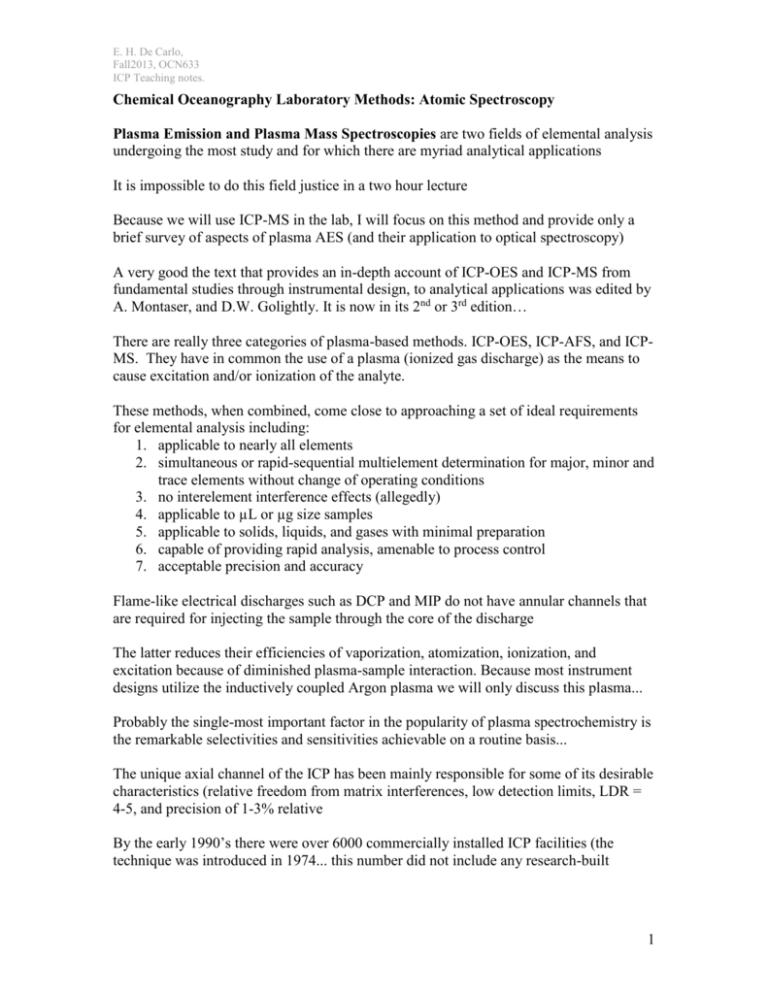
E. H. De Carlo,
Fall2013, OCN633
ICP Teaching notes.
Chemical Oceanography Laboratory Methods: Atomic Spectroscopy
Plasma Emission and Plasma Mass Spectroscopies are two fields of elemental analysis
undergoing the most study and for which there are myriad analytical applications
It is impossible to do this field justice in a two hour lecture
Because we will use ICP-MS in the lab, I will focus on this method and provide only a
brief survey of aspects of plasma AES (and their application to optical spectroscopy)
A very good the text that provides an in-depth account of ICP-OES and ICP-MS from
fundamental studies through instrumental design, to analytical applications was edited by
A. Montaser, and D.W. Golightly. It is now in its 2nd or 3rd edition…
There are really three categories of plasma-based methods. ICP-OES, ICP-AFS, and ICPMS. They have in common the use of a plasma (ionized gas discharge) as the means to
cause excitation and/or ionization of the analyte.
These methods, when combined, come close to approaching a set of ideal requirements
for elemental analysis including:
1. applicable to nearly all elements
2. simultaneous or rapid-sequential multielement determination for major, minor and
trace elements without change of operating conditions
3. no interelement interference effects (allegedly)
4. applicable to µL or µg size samples
5. applicable to solids, liquids, and gases with minimal preparation
6. capable of providing rapid analysis, amenable to process control
7. acceptable precision and accuracy
Flame-like electrical discharges such as DCP and MIP do not have annular channels that
are required for injecting the sample through the core of the discharge
The latter reduces their efficiencies of vaporization, atomization, ionization, and
excitation because of diminished plasma-sample interaction. Because most instrument
designs utilize the inductively coupled Argon plasma we will only discuss this plasma...
Probably the single-most important factor in the popularity of plasma spectrochemistry is
the remarkable selectivities and sensitivities achievable on a routine basis...
The unique axial channel of the ICP has been mainly responsible for some of its desirable
characteristics (relative freedom from matrix interferences, low detection limits, LDR =
4-5, and precision of 1-3% relative
By the early 1990’s there were over 6000 commercially installed ICP facilities (the
technique was introduced in 1974... this number did not include any research-built
1
E. H. De Carlo,
Fall2013, OCN633
ICP Teaching notes.
instruments)… by then, ICP methods had largely replaced AAS/AES in most commercial
laboratories
Despite the great popularity of the ICP techniques, there are still areas where much
further research is needed.
These include sample introduction, and diagnostic and mechanistic studies of processes
prevailing in the ICP
The former needs much work because sample introduction remains a very ineffective
process in ICP spectrometry
Study of fundamental processes is necessary to allow spectroscopists to devise better
sources through understanding of the fundamentals of discharges
Before we focus on the ICAP (A for argon) ... a few words about some other plasmas
Direct current plasmas: used exclusively for optical methods and have relatively good
operating conditions. DC plasmas represent a useful and valuable analytical tool.
- three electrode discharge is fairly widely used
- plasma is formed between three electrodes arranged in an inverted Y configuration
- operates at Ar flow of ~7 L/min using a single phase, 20 A d.c. power supply
- uses graphite anodes and tungsten cathode, all are water cooled and enclosed in ceramic
sleeves
- major problem is consumption of electrodes requiring their adjustment every few hours
- analytical observation are made under the arc column
- fewer strong ion (emission) lines than in the ICP
- primarily use Ar as plasma gas
- newest aspect is a conical DCP which should become more popular because of
increased sample penetration into the core of the discharge
Microwave-induced plasmas: usually operate at low (100W) to moderate (500 W) power
relative to ICP (usually > 1 kW)
- generated by either Beenakker cavity or Surfatron cavity... (see reference for diagrams)
- latter seem to be easier to operate and tune
2
E. H. De Carlo,
Fall2013, OCN633
ICP Teaching notes.
- MIP's (even the annular types) are usually in contact with the plasma containment tube
- this leads to gradual erosion of the inside wall of the torch, a disadvantage not present in
the ICP...
- capacitively coupled MP are also available
- they require minimum impedance matching but because microwave energy is conducted
through a coaxial waveguide to the tip of the electrode, the plasma is not as free from
contamination as the ICP
- can use alternate gases such as N2, He, or Ne besides Ar
Plasma Emission:
The ICP (RF) plasma was described as early as 1956 but not commercially developed
until the mid 1970's
A simple description follows: Ar flows through open tube concentric with a RF coil,
which sets up an oscillating electromagnetic field
Ionization of Ar is initiated with Tesla discharge or other appropriate means that
introduce a few electrons into the torch...
Ar ions generated by the Tesla discharge are caught in an oscillating EM field and try to
follow field...
The rapid changes in the magnetic field induces eddy currents in the gas
Resistance to the eddy current flow produces Joule heating
The rapidly changing magnetic field also sets up oscillation of Ar ions... collisions with
other unionized Ar which become ionized.... etc...
The number of ions increases rapidly until the gas population is mostly ionized and a
steady state is reached...
Once the ionizing temperatures have been reached the process is self-sustaining, this is
now a PLASMA...
Extremely high translational energy of Ar ions leads to high T in Boltzmann distribution
(note: electronic temperatures are measured by emission intensity)
The electronic temperature in ICP is in the range of 5,000-15,000 K
3
E. H. De Carlo,
Fall2013, OCN633
ICP Teaching notes.
The latter occurs only within annular discharge and in the "hole" temperature is believed
to be lower than the maximum, i.e., 8,000-10,000K
Because the plasma is made of Ar+ and electrons it is easy for other free atoms to ionize
SEE TABLE OF IONIZATION POTENTIALS
Ionization is followed by excitation of ions and the resultant emission of light from ionic
transitions often provides the best sensitivities (for ICP-OES). In mass spectrometric
applications, the ions are introduced into a the mass spectrometer focused, and then mass
filtered.
Some advantages of plasmas relative to other (optical or ion) sources include:
1.
2.
3.
4.
5.
6.
7.
much hotter than flames or electrical discharges
capable of exciting all metals and metalloids (non-metals also to lesser extent)
much more stable and reproducible than signal obtained in electrical discharge ES
lower background and fewer interference effects
steady state signal with continuous sample introduction
amenable to multi-element (simultaneous or sequential)
sensitivity for some elements much greater in ICP-OES than in AAS, and
extremely good for ICP-MS (especially with the newer high resolution magnetic
sector instruments).
The basic relationship governing the intensity of an atomic line emitted from a
homogeneous plasma of thickness x into the interval ±dl/2 about wavelength l is
I(l)dl = h/(4π){AulnuL(l)dl}
where L(l) is the line shape factor (beyond the scope of this lecture), A is the Einstein
coefficient giving the probability for spontaneous transitions from upper state u to lower
state l, and n is the emitter number density of atoms (or ions) in excited state u.
In reality emission from a plasma is much more complex than described above,
particularly if the plasma is not optically thin... not in local thermodynamic equilibrium...
etc. (Refer to Chapter 2 in Montaser and Golightly for detailed treatment of the problem)
Instrumentation for ICP-OES
Instrumentation for ICP-OES is similar yet significantly different from that used in other
optical methods such as AAS and flame AES...
One of the most important design characteristics of ICP-OES spectrometers is a need for
high resolution (because of potential spectral interferences)
4
E. H. De Carlo,
Fall2013, OCN633
ICP Teaching notes.
High (optical) resolution has been achieved by several means... double monochromators,
echelle spectrometers, use of holographic gratings...
Basic design consists of sample introduction, Ar gas systems, induction coil and
associated RF generator, torch, and optical system for wavelength isolation and detection
+ assorted whistles and bells...
RF generators are oscillators that generate an alternating current at a desired frequency
The basic design is simple: a capacitor and an inductor (coil) in parallel... this constitutes
a "tuned circuit" or "tank circuit"
When the capacitor is discharged through the inductor the subsequent collapse of the
magnetic field causes charge buildup on the capacitor with a charge opposite to that
present initially.
In absence of a resistance of the circuit this process would go on indefinitely... actually
though the oscillation will gradually decrease unless enough electrical energy is
transferred into the tuned circuit
Transfer of additional energy is done by a feedback system... the major difference in
various oscillators is in the feedback process
There are many designs for RF generators (refer to text by Montaser and Golightly)
The two major types of oscillators used in plasma spectrometry are free running or crystal
(piezoelectric) controlled
In free running systems the basic frequency of oscillation is fixed by the values of the
components in the tank circuit; these in turn are modified by changes in the plasma
impedance (when you aspirate anything that disturbs it) and in the coupling of the plasma
to the load coil
In the other type of system a piezoelectreic crystal is used to control the feedback and to
maintain constant frequency
RF generators/oscillators usually operate at <2 KW and 27.12 MHz or at 40.6 MHz
Higher frequency of oscillation leads to lower excitation and ionization temperatures,
lower electron number densities and lower continuum background with improved
background stability
With improved stability and lower background, superior detection limits are achievable
(detection limits improve markedly as frequency is increased from 5 to 40 MHz)
5
E. H. De Carlo,
Fall2013, OCN633
ICP Teaching notes.
The greater stability of higher frequency models allows aspiration of higher TDS fluids
into the plasma or even of liquids (such as organic solvents) that normally disrupt the
plasma.
The higher frequency systems also work better with nitrogen or air plasmas
It is important to prevent the high-frequency field from radiating outside the instrument
and adequate shielding is necessary to confine the RF field to the generator case and
torch compartment.
Early RF generators were MONSTERS.... typical units were the size of home
refrigerators making the whole system unwieldy
Older systems needed seed plasma generation prior to formation of actual plasma within
load coils, newer ones generally have automatic ignition
Newer systems are much more compact... RF generators can still weigh about 250 lbs
and be 3ft X 1ft X 1ft, the RF generator in the VG-PQ2S ICPMS is even smaller.
Solid state RF generators are also available, these are based on solid state-static inverter
circuits (reverse of a rectifier or converter... takes d.c. and makes into a.c. at desired
frequency)
Torches: many designs now available, but basically all follow same principle
Three streams of Ar gas flow through three concentric quartz tubes leading to the RF coil
The functions of three streams are:
1. sample transport
2. plasma gas (i.e., that which forms the plasma) and torch coolant, and
3. auxiliary flow gas to position plasma vertically in the torch
Gas flow rates are usually ~0.4-1.5 L/min, ~15 L/min, and highly variable respectively.
On the VG-PQ2S ICP-MS system at UH we use ~0.9 L/min, ~14 L/min, and 0.8-1.3
L/min, respectively.
Torches are made of quartz, can be single unit or demountable, typical system has an o.d.
of about 20 mm.
Demountable torches allow use of alternative materials for the injector tip such as boron
nitride, aluminum, or ceramics... generally used for resistance to corrosion from sample.
Newer torches have been designed to lower Ar consumption, many are mini-torches with
40-50% decreased gas consumption, often, however, they require external cooling (water,
forced air) as high Ar flows (of normal torches) are needed for self-cooling.
6
E. H. De Carlo,
Fall2013, OCN633
ICP Teaching notes.
The next important component in ICP-OES (or ICP-MS) is sample introduction
The general principles of sample introduction of other flame methods are applicable...
however, a few differences exist.
Overwhelmingly... the sample is in liquid form.
Techniques do exist for gas and solid introduction but commercial devices remain few.
Routine techniques for direct solid introduction are lacking.
Laser ablation however is the most promising means of dealing with solids on a repetitive
and especially site-specific basis.
Analyte transport efficiency in ICP-OES and ICP-MS using conventional nebulization is
typically lower than in flame (optical) methods.
Pneumatic nebulizers are generally of concentric or cross flow design.
The Nukiyama and Tanasawa equation is applicable to conventional nebulization in ICPOES
Concentric nebulizers such as the Meinhard design are prone to clogging by solutions
with high TDS, generally cross flow is better in this sense, yet the Meinhard or its
offshoot (the gas expansion nebulizer) are most commonly used in ICP-MS.
The Babington nebulizer is a variant of cross flow nebulizer:
The solution is pumped through a glass tube that terminates in a hollow sphere, where it
emerges from a small hole in the top of the sphere to form a thin film over the outside
surface. Gas is forced through a small horizontal slot in the sphere, ruptures the film and
produces an aerosol
The hole where sample emerges in the Babington nebulizer is rather large ===> not
prone to clogging
The Hildebrand grid nebulizer (HGN, used in Leeman systems) is also a variant of a
cross-flow nebulizer
Sample is drawn through a capillary and wets the surface of a fine Pt grid and is then
sheared by a flow of Ar
The HGN lowers detection limits of a conventional nebulizer by about a factor of 2-3
Ultrasonic nebulization is another sample introduction technique, in which a piezoelectric
crystal is driven at 0.2-10 MHz and used to break up liquid films into an aerosol
7
E. H. De Carlo,
Fall2013, OCN633
ICP Teaching notes.
Nebulizers are typically combined with a spray chamber to decrease the droplet size to
that acceptable for spectroscopy. As with nebulizers, several designs exist for spray
chambers; all, however, serve the same basic purpose.
Equipment also exists, in which drying of the aerosol occurs through heating on its way
through the system, thereby allowing much greater analyte transport into the plasma. A
big advantage of such desolvation (removal of water) in ICP-MS is the lowering of oxide
formation in the plasma.
ICP-OES instrumentation generally requires much higher (optical) resolution than in
flame methods in order to deal with spectral interferences (nearly everything in the
sample emits light)
Improved resolution is generally achieved by using double monochromators (or
polychromators), echelle spectrometers, and/or holographic gratings.
Some systems include:
Leeman Labs: echelle spectrometer (with echelle grating before the prism). Echelles
were initially designed for use in emission spectrography and used with d.c. plasmas
-
operates at high angles, system blazed at high angles, max intensity at blaze angle,
use of high orders to keep operation in the blaze angle region.
<0.01 nm resolution
fixed optics, moving PMT
can be simultaneous or sequential
Perkin Elmer: The Optima family of optical emission spectrometers is based on an
Echelle polychromator with a Segmented Array Charge Coupled Device detector (SCD).
The result is a simultaneous spectrometer that has resolution of 0.006 nm in the spectrally
congested UV region.
Thermo-Jarrell Ash: The Intrepid II spectrometers are also based on Echelle optics. The
systems can be configured for radial, axial or duo (radial and axial) plasma viewing.
- also manufacturer of ICP-AFS instrumentation.
Instruments SA, Jobin-Yvon: Czerny-Turner optics with holographic gratings in simple
systems. Ultima series instruments provide various options. The basic design utilizes an
80 x 100 mm holographic grating with 2400 grooves/mm provides resolution of 0.008 nm
at wavelengths less than 320 nm.
Varian: the main systems use an Echelle polychromator with a focal length of 40cm. The
otpical element includes a CaF2 prism cross disperser. Na and Echelle grating (94.74
8
E. H. De Carlo,
Fall2013, OCN633
ICP Teaching notes.
lines/mm). Creates echellogram of 70 orders which is projected onto a charge coupled
device (CCD) detector.
Double monochromator system using tandem Czerny-Turner design.
- potential problem with scattered light from the first grating is diminished by using
gratings made using interference fringes and that have no blaze angle.
- improved resolution over single Czerny-Turner design.
- uses refractal plate to find wavelength peak in area where it should be
Definition: Blaze wavelength is defined as that wavelength for which the angle of
reflectance from the groove face and the angle of diffraction from the grating are
identical.
Spectral region wherein the intensity is greater than one-half the intensity at the blaze
wavelength in its first order extends approximately from 2/3 the blaze wavelength to 2
times the blaze wavelength. For higher orders it is more balanced from 2/3 to 3/2 the
wavelength.
note: a grating looks like a good mirror to wavelengths longer than the groove spacing.
ICP-MS:
Before describing the instrumentation in greater detail, here are a few reasons why this is
such a popular method.
Detection limits of 10-100 pg/mL routinely with 1 pg/mL achievable with fairly little
effort on the newer machines (this is 100 to 1000 better than ICP-OES).
Mass spectra are considerably simpler than optical spectra (particularly true with
lanthanides).
Isotope abundance spectra provide a rapid qualitative tool.
Linearity for over 6 decades (allegedly, but not really)...
The ICP is an excellent ion source. Efficiencies of ionization range from near
quantitative for about 40 elements and quite favorable for many more (see table 10.2 in
handout).
Basic design faced biggest problem of interfacing ICP (high pressure and temperature)
with MS (low pressure and temperature).
9
E. H. De Carlo,
Fall2013, OCN633
ICP Teaching notes.
Finnigan, Hewlett-Packard (Yokogawa), SCIEX, Varian, and Thermo-VG are prime
makers of ICP-MS instrumentation.
Systems are often similar with a quadrupole (or magnetic sector) ms interfaced with the
ICP through a set of metallic cones.
- first cone is a sampling cone with an orifice of 1mm and the whole interface is water
cooled
- second cone is a skimmer cone placed 2-10 mm behind the sampling cone
- latter has same diameter orifice as sampling cone but is more sharply tapered.
- region between two cones is evacuated to 1 torr or less
- sampling cones made of metal... usually use Ni (or Pt) which last several months before
replacement is needed (Pt cones last longer, but cost much more)
- skimmer cone is made of same materials as sampling cones but often lasts about a year
- interface between ICP and MS is critical subsystem of instrumentation. It is the area
where manufacturers tend to differ mostly in their design
- a discharge can form between the two cones and has been a source of problems (oxide
formation, complex ions, etc.)
- Sciex use a center-tap grounded ICP load coil to minimize plasma voltage and seems to
eliminate the discharge formation between the two cones
- Thermo-VG use bias voltages to the skimmer and sampler cones to minimize the
discharge
- high vacuum (ultra low P) part of spectrometer following the skimmer contains input
ion optics, the quadrupole, and the ion detector.
- main ms part of system is kept at approximately 10-6 torr. Sciex use one stage
cryogenic pumping whereas VG use two stages of mechanical pumping.
- input ion optics consist of ion lenses and a Bessel box to block photon passage
- further reduction in photon noise is achieved by deflection of ions exiting the
quadrupole to an off-axis detector.
- detection with continuous scanning, peak hopping...
10
E. H. De Carlo,
Fall2013, OCN633
ICP Teaching notes.
- resolution needed is not high if avoid oxide formation... 0.5 to 1 amu (width at 10%
height)
- there are many parameters that affect the operation of an ICP/MS system (see table
10.2)
- most of these do not need to be routinely adjusted but forward power, gas flows, and ms
input ion-optic voltages have major effects on analyte ion signals
- forward power and gas flows are the most important and appear to operate as a paired
set of variables (if one is changed the other must also be changed to maximize the signal)
- because of similar characteristics for different elements, it is possible to use
compromise settings for analysis of elements that span 3 rows of the periodic table and
have significantly different masses and ionization potentials
-iInput optic voltages are very important... settings depend on instrument design and type
of input ion optics.
- one of the critical values is in the voltage on the photon stop in the Bessel box
(optimized setting is dependent on mass)
- although spectral simplicity is ICP-MS's biggest claim to fame... it is not so simple...
spectral overlaps do occur although not nearly as bad as in ICP-OES
- molecular species and doubly charged ions also cause some problems
- isobaric interferences occur as a result of the isotopic composition of various elements
and can also occur from oxide formation, doubly charged ions, and combination products
with Ar.
- some examples: mass 48 for both Ti and Ca; can correct for the Ca contribution by
measuring 44Ca and subtact 0.0891 of this measured counts from the 48 mass... NOTE
CAVEAT EMPTOR
- background spectral features are also important. Refer to figures 10.9 and 10.10 for dd
H2O
- matrix composition can also cause problems. Cannot use HCl to dissolve samples
containing As or V because the 40Ar35Cl interferes with 75As and 35Cl16O interferes with
51
V, and both elements are MONOISOTOPIC.
- oxide and hydroxide formation also can be problematic. The idea is to use conditions
appropriate to minimize the formation of these unwanted species. Usually involves
changing in RF power and injector gas flow rate, and cooling the spray chamber, etc.
11
E. H. De Carlo,
Fall2013, OCN633
ICP Teaching notes.
- matrix induced spectral overlaps are also important:
Example: 47Ti16O and 23Na40Ar interferes with 63Cu, 49Ti16O interferes with 65Cu, 16O40Ar
precludes analysis of 56Fe. There are many other isobaric intereferences, especially in the
mass range below 80 amu.
- another problem is the effect of large amounts of a matrix element on the signal from a
trace component. This remains poorly understood but for some reason large excesses of
matrix elements cause significant signals at the mass/e- of the analyte of interest.
- one final note is that for mass range above 80 there are generally few background
interferences, and the spectra become much more readily interpreted... then you are left
primarily with the possibility of oxide and hydroxide formation.
GC/HPLC/plasma-OES or MS
I have very little to say about this except that there is a renewed interest of using plasma
OES or MS as an element specific detector.
The interest is particularly with organic compounds that have been chlorinated or
fluorinated or other compounds where you can make a metal-organic complex.
Additionally, one can use ICP-OES or ICP-MS for detection of metals separated by
HPLC/ion chromatography.
12

